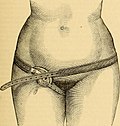Truss (medicine)
Truss (medicine)[edit]
A truss is a medical device used to provide support and relief for patients suffering from a hernia. It is designed to hold the protruding tissue in place and prevent further protrusion through the abdominal wall. Trusses are typically used as a non-surgical treatment option for hernias, especially when surgery is not immediately possible or advisable.

History[edit]
The use of trusses dates back to ancient times, with evidence of their use found in Ancient Greece and Ancient Rome. Early trusses were often made from materials such as leather and metal. Over the centuries, the design and materials used in trusses have evolved, with modern trusses being made from more comfortable and durable materials such as elastic and foam.
Design and Function[edit]
A truss typically consists of a pad that applies pressure to the hernia site, a belt or strap to hold the pad in place, and sometimes additional straps for added support. The pad is positioned over the hernia, and the belt is fastened around the body to keep the pad securely in place. The pressure applied by the pad helps to keep the herniated tissue from protruding further.
Types of Trusses[edit]
There are several types of trusses, each designed for specific types of hernias:
- Inguinal hernia truss: Designed for hernias in the groin area, these trusses often have a pad that applies pressure to the inguinal canal.
- Umbilical hernia truss: Used for hernias around the navel, these trusses have a circular pad that fits over the umbilical area.
- Femoral hernia truss: Similar to inguinal trusses but designed to support hernias that occur lower in the groin.
Usage and Effectiveness[edit]
Trusses are generally used as a temporary measure to manage hernia symptoms. They are not a cure for hernias and do not replace the need for surgical intervention. However, they can provide relief from discomfort and prevent the hernia from worsening. It is important for patients to consult with a healthcare professional to ensure proper fitting and usage of a truss.
Risks and Considerations[edit]
While trusses can be beneficial, they also come with potential risks. Improper use or fitting of a truss can lead to complications such as skin irritation, pressure sores, or even strangulation of the hernia. Patients should be monitored regularly to ensure the truss is functioning correctly and not causing harm.
Related Pages[edit]
| Medical devices | ||||||||
|---|---|---|---|---|---|---|---|---|
This medical device related article is a stub.
|
Truss (medicine)[edit]
-
A Reference handbook of the medical sciences - embracing the entire range of scientific and practical medicine and allied science (1885)
Ad. Transform your life with W8MD's Budget GLP-1 injections from $75


W8MD offers a medical weight loss program to lose weight in Philadelphia. Our physician-supervised medical weight loss provides:
- Weight loss injections in NYC (generic and brand names):
- Zepbound / Mounjaro, Wegovy / Ozempic, Saxenda
- Most insurances accepted or discounted self-pay rates. We will obtain insurance prior authorizations if needed.
- Generic GLP1 weight loss injections from $75 for the starting dose.
- Also offer prescription weight loss medications including Phentermine, Qsymia, Diethylpropion, Contrave etc.
NYC weight loss doctor appointmentsNYC weight loss doctor appointments
Start your NYC weight loss journey today at our NYC medical weight loss and Philadelphia medical weight loss clinics.
- Call 718-946-5500 to lose weight in NYC or for medical weight loss in Philadelphia 215-676-2334.
- Tags:NYC medical weight loss, Philadelphia lose weight Zepbound NYC, Budget GLP1 weight loss injections, Wegovy Philadelphia, Wegovy NYC, Philadelphia medical weight loss, Brookly weight loss and Wegovy NYC
|
WikiMD's Wellness Encyclopedia |
| Let Food Be Thy Medicine Medicine Thy Food - Hippocrates |
Medical Disclaimer: WikiMD is not a substitute for professional medical advice. The information on WikiMD is provided as an information resource only, may be incorrect, outdated or misleading, and is not to be used or relied on for any diagnostic or treatment purposes. Please consult your health care provider before making any healthcare decisions or for guidance about a specific medical condition. WikiMD expressly disclaims responsibility, and shall have no liability, for any damages, loss, injury, or liability whatsoever suffered as a result of your reliance on the information contained in this site. By visiting this site you agree to the foregoing terms and conditions, which may from time to time be changed or supplemented by WikiMD. If you do not agree to the foregoing terms and conditions, you should not enter or use this site. See full disclaimer.
Credits:Most images are courtesy of Wikimedia commons, and templates, categories Wikipedia, licensed under CC BY SA or similar.
Translate this page: - East Asian
中文,
日本,
한국어,
South Asian
हिन्दी,
தமிழ்,
తెలుగు,
Urdu,
ಕನ್ನಡ,
Southeast Asian
Indonesian,
Vietnamese,
Thai,
မြန်မာဘာသာ,
বাংলা
European
español,
Deutsch,
français,
Greek,
português do Brasil,
polski,
română,
русский,
Nederlands,
norsk,
svenska,
suomi,
Italian
Middle Eastern & African
عربى,
Turkish,
Persian,
Hebrew,
Afrikaans,
isiZulu,
Kiswahili,
Other
Bulgarian,
Hungarian,
Czech,
Swedish,
മലയാളം,
मराठी,
ਪੰਜਾਬੀ,
ગુજરાતી,
Portuguese,
Ukrainian
